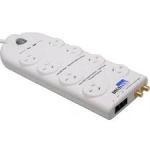Fuses,Circuit Breakers and Safety Switches
These devices are found in your Switch board understanding these devices and how to use and maintain them will help your management and understanding of Electrical Safety in the Workplace.
Primary Overload response devices (Fuses & Circuit Breakers)
Fuses and circuit breakers are built to fail in conditions of excess current which can overload the electrical wires in your home. These overloads are often caused by faulty appliances. When an overload occurs, the fuse melts before the wires can overheat, which reduces the risk of fire. Circuit breakers will often trip quicker and more importantly they can be reset to help diagnose and remove faults
- Always replace a blown fuse with the correct fuse wire. Never use fuse wire that is heavier than the recommended gauge.
- Never use any other type metal or wire.
- If fuses keeps blowing, or a circuit breaker keeps tripping, check that your appliances are not faulty.
- If fuses continue to blow, or circuit breakers continue to trip after appliances are unplugged, there could be a problem with your wiring. Contact a licensed electrician immediately.
Safety switches
Safety switches look similar to circuit breakers, but they provide extra protection from electric shock. Safety switches monitor the flow of electricity and if any irregularity is detected, the electricity supply is immediately cut off.
Homes with children or backyard workshops should consider installing safety switches to reduce the risk of electrical accidents. New homes are required to have safety switches installed. Licensed electrical contractors can install safety switches in older homes at a reasonable cost. You can also purchase portable safety switches for appliances and extension cords. Useful particularly when using power tools outside ie Electric Lawnmowers, Hedge trimmers, Drills, circular Saws etc
<<<<<<<<<<<<<<<<<<<<<<<<<< 0 >>>>>>>>>>>>>>>>>>>>>>>>>>>
Of course the best way is to ensure that your appliances are not hazardous in the first place. Tested & True ~ test & tag comes to your work place at a time convenient to you. We can do an assessment of your Electrical Hazards it can be conducted at the same time as we test and tag your Electrical Equipment. We provide a Full Report with recommendations to clear up current Hazards and how to prevent future risks. Call and ask for a quote. 040 7605568..
Note: We also do emergency and preventative maintenance of Switchboards and Mains Wiring
Tested & True ~ test & tag Adelaide uses the very latest in Portable Appliance Testing…The STC ProLogger 2 it can perform static testing class 1,2 & M RCD testing, Earth Leakage Detection, 3 phase run testing and logs results as you test. all in one neat piece of equipment. On top this all our Technicians are Trained to National Standard UEENEEP008 in test & tag operations by Intertag in Sydney NSW, all our Equipment is in good repair and in Calibration. Most of all we pride ourselves on our Knowledge of OH&S legislation and the current Australian Standards ensuring that you get Quality Service at a competitive price.
Call Now Mobile 040 7605568
Visit us at
or our Newsletter http://testedtruenewsletter.blogspot.com/
Peter Hill Manager , Tested & True ~ test & tag Adelaide August 2013

















